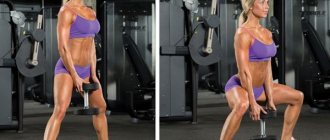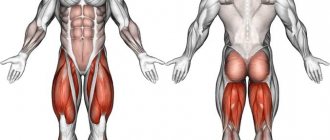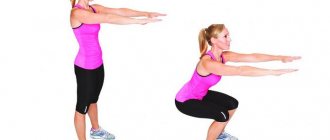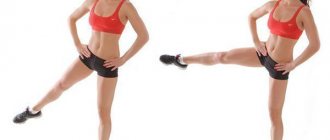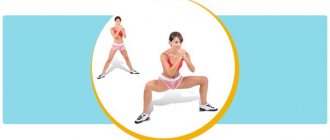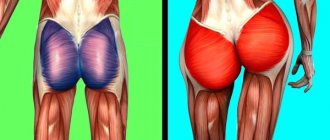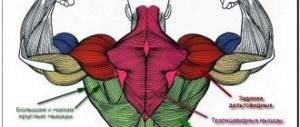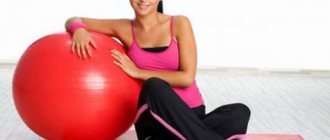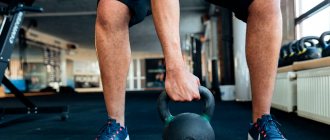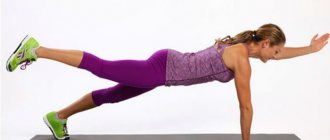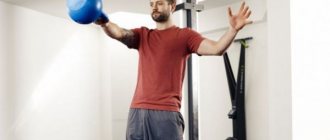Deep squats - These are weightlifting squats that involve lowering the pelvis much below the “parallel” line, due to which it is possible to use those parts of the muscles that are not involved in bodybuilding squats with a barbell. Deep squats involve tilting the body forward and extending the knees beyond the line of the toes, and therefore, these squats are either avoided, or, when they see someone doing them, they smartly say that this is not the right way to do it! Indeed, if you are a girl and want to pump up a beautiful butt, then a deep squat is clearly not suitable for you, but if you are a man and you are interested in strength indicators, then as an auxiliary exercise this type of squats can not only be included in the training plan, it is there must be turned on!
Deep squats, contrary to belief, do not “kill” the knees, otherwise all Soviet Olympic weightlifting champions would be disabled, but this is not so! Indeed, tilting the body forward and bringing the knees beyond the line of the toes, trying to squat with maximum weight, is not advisable, since the athlete has to overcome a longer range of motion. This is why deep squats are not practiced in powerlifting, or rather, they are used as an “auxiliary”, and in competitions they perform squats with a different technique. This rule applies to any exercise, including the bench press. At competitions, they don’t press the barbell with a narrow grip; they always use the widest possible grip, since this reduces the amplitude. At the same time, this does not mean that the close-grip bench press should not be included in the training program!
Squat Depth Study
17 physically active men were recruited to participate in the experiment, but they had no experience in weight training. Participants were randomly assigned to training groups, one of which performed full squats in the 140-degree range (FST), the other performed half-amplitude squats in the 90-degree range (HST). The duration of the experiment was 10 weeks. The training program consisted of visiting the gym twice a week, where participants performed three sets of barbell squats at an intensity of 8 RM (8 repetitions to failure). Before and after the program, magnetic resonance imaging was used to measure the volume of the knee extensor muscles (all quadriceps muscles separately), hamstring muscles (semitendinosus, semimembranosus and biceps muscle), adductor and gluteal muscles, as well as a maximum of one repetition for the full and half squat.
Exercise options
To get the most out of your exercises, you should pay more attention to increasing the range of motion rather than focusing on the number of repetitions. At first it will be difficult to hold the body up after a full squat even for a couple of seconds, but after regular training you will be able to withstand 10 minutes without significant effort.
Exercise 1: Wall Squats
For beginners, this method of deep squats will seem the easiest. When the technique of the exercise is perfected to the smallest detail, and it becomes easy to do, it is worth complicating it using a barbell. This will make your training more effective.
Starting position: standing against the wall, feet shoulder-width apart, arms straight in front of the chest, toes forward.
- Perform a squat so that your thighs are parallel to the floor. In this case, the upper back, pelvis and head should touch the wall.
- Stay in this position for several seconds.
- Take the previous position, straightening your knees.
If doing such squats is difficult at first, you can reduce the range of motion. At first, it is enough to hold the body in a squat for a couple of seconds, gradually increasing the time. When you manage to fix the position for 1 minute, lowering yourself several times in a row, you can move on to a more difficult level.
Exercise 2: squats on a step platform
By decreasing or increasing the step platform, you can change the difficulty level of this exercise. The height of the support must be at least such that during a squat the thighs are parallel to the floor. Instead of a step platform, you can use a chair, box, sofa, etc.
Starting position: feet shoulder-width apart, toes forward.
- Pull your pelvis back as far as possible.
- Transfer the load to the thigh muscles, bend your knees. Slowly sit down on the support.
- Lock yourself in this position.
- Bend your body forward and stand up, tensing your buttock muscles. Take the starting position with your knees straightened.
Before moving on to a more difficult level, you should perform several sets of 10 squats.
Exercise 3: Deep squat without weights
When performing this exercise, the knees will bend forward at a certain stage. However, this must be avoided. It is important to keep your shins almost vertical.
Starting position: feet shoulder-width apart, toes turned forward, body straight.
- Move your pelvis as far back as possible.
- Slowly squat down, lowering your body as low as possible. It is advisable to keep your back as straight as possible.
- Lock yourself in this position.
- Leaning forward, stand up, transferring the tension to the muscles of the buttocks.
A few sets of 10 squats are enough to begin more complex exercises.
Exercise 4: Deep overhead squats
Starting position: feet shoulder-width apart, toes turned forward, arms above your head, back straight.
- Move your pelvis back.
- Bend your knees and slowly squat down. The body should be lowered as far as possible. The back is almost straight.
- Lock the squat.
- Stand up, leaning your body forward. The buttock muscles are tense.
Having gained experience, you need to complicate the task by picking up a barbell. It is enough to perform several approaches of 10 squats.
Exercise 5: Deep Squat with Suspension Straps
First you need to attach the straps to the support. It must be secure to avoid injury.
- Grasp the handles, tightening the straps. Hands are held at chest level, elbows bent.
- Perform a deep squat with your feet shoulder-width apart. Your arms can be straightened.
- Fix the muscles in this position.
- Get up. Take the starting position.
Exercise 6: Deep Barbell Squats
Starting position: feet shoulder-width apart, holding a barbell in your hands at chest level, body straight.
- Pull your pelvis back.
- Perform a squat with a barbell. The body should be lowered as low as possible.
- Hold your body in this position, tensing your muscles, for several seconds.
- Rise up to the starting position.
It is recommended to perform deep squats with a barbell only after you have gained experience with simpler exercises.
Deep squat 140 degrees or squat 90 degrees: which turned out to be more effective
The relative increase in one-rep max in the full squat was significantly greater in the FST (31.8%) than in the HST (11.3%), while for the half squat there was little difference between the FST (24.2%) and the HST (32. 0%).
These results are obvious - the principle of specificity in relation to the motor skill being developed. To maximize the development of strength in a particular exercise, you need to perform this particular exercise, and not with similar biomechanics.
Since, despite the fact that when performing similar exercises the same muscles can develop, the coordination of their mutual work with each other will be different. Therefore, the one who did full squats showed the greatest strength in them.
In the half-amplitude squat, the difference in maximum strength between participants is small, since both were actually working in the range from 0 to 90 degrees. Only some stopped there, while others sank even lower.
Deep squat technique
To learn the correct technique, you should spend a fairly large amount of time (1-3 months). This technical foundation will benefit you in the future in the form of long-term progress. The emphasis should be on low intensity (purely technical work with light weights - not on muscle growth). Learning the technique of deep squats can go in parallel with performing squats to parallel or other exercises for the leg muscles.
Learning the technique: tilting the body forward even in a deep squat is minimal
Pay increased attention to the development of flexibility, agility and coordination: jumping, sprinting and stretching (stretching is best done at the end of the workout, more details here) - all this should be included in the complex, but without fanaticism.
How to take the starting position (approaching the barbell, taking the weight and taking the starting position) is written in detail in the article about classic squats. Briefly the main points:
- Remove the barbell from the racks using the strength of your legs (by sitting under the apparatus and straightening your legs), not your back (by straightening your back).
- The most economical move back from the racks is 2-3 steps.
- The bar rests comfortably on the trapezius or rear deltoid.
- In the initial position, the body has a natural slight tilt forward, the chin is parallel to the floor.
- The socks are turned out, the knee looks at its toe.
The key to performing a deep squat is maintaining a constant fulcrum. This is the middle of the foot. Those. the weight is evenly distributed over its entire surface, there is no shift to the toe or heel.
The whole point of the movement (lowering and rising) is to keep the fulcrum constant by balancing the body.
Lowering
As you inhale, begin to lower yourself into a squat position, while trying to maintain the position of your torso as in the starting position. Avoid folding your body forward and transferring your body weight to your toes.
While learning the technique, find the optimal degree of pelvic abduction for yourself, at which your body will be as vertical as possible, while constantly monitoring the support (the entire foot).
The most important points of the amplitude are the moment the descent begins and the passage of the parallel. If you deviate from your ideal trajectory, this will lead to a shift in load vectors and all your efforts will be aimed at maintaining body balance, and not at working the target muscles.
Features: slight inclination of the body, support on the entire foot, toes spread, knees pointing towards their toes, chest not tucked forward.
During the passage of the parallel, the pelvis will naturally begin to tuck, as if “rounding” the lower back. This is an absolutely physiological phenomenon. Your task is not to fall forward, rounding the chest towards the toes. Just keep the same back tension and clear control of the support (over the entire foot).
Having reached the “bottom” (the lowest point, i.e. complete graying), do not relax the muscles, transferring the weight to the joints and ligaments.
Climb
During the climb, it is important to maintain the same trajectory and fulcrum. The moment of being in a deep squat should be minimal, followed by an explosive and powerful rise. The most problematic point of amplitude during extension is the middle. That is why a sharp start will ensure successful completion of this section.
Control the angle of your torso, avoiding tilting your back forward, and get to the starting position with your full foot.
Extensor muscle volume increases regardless of squat depth
The volumes of the knee extensor muscles increased significantly in both groups, the difference between the groups was not significant (4.9% in FST and 4.7% in HST). However, one of the quadriceps bundles, the rectus femoris muscle, showed an increase of less than 1%.
(This is the same muscle that raises the hip when walking, anatomically this movement is called hip flexion). Low height can be explained by the peculiarity of the attachment of the rectus muscle; when performing a squat, it simultaneously contracts and stretches, which reduces the degree of its dynamic work. Working less means developing less.
Hamstring muscle growth does not depend on squat depth
The volume of the hamstring muscles (the muscles of the back of the thigh) in both groups increased minimally - less than 1%. Here the situation is similar with the rectus femoris muscle - simultaneous contraction and stretching, a decrease in the degree of participation in work.
Scientists' conclusions about the effectiveness of squat depth
The results of the study show that full squat training is more effective for developing the muscles of the lower extremities, with the exception of the rectus femoris and hamstring muscles. If the goal of performing squats is to develop the gluteal and adductor muscles, then the full amplitude is preferable. In practice, due to individual anatomy, full squats may provide little benefit in developing the buttocks for some, although it will still be better than half-amplitude squats. When the goal is maximum hypertrophy, for the full development of the hip, squats alone are not enough. A little isolation wouldn’t hurt, for example, flexions or hyperextensions for the hamstrings and extensions; in them, the rectus muscle works more efficiently than in different variations of squats.
What are deep squats for?
Deep squats help build muscle mass, especially when performed with weights. Due to its high energy intensity, it is possible to burn fat, thereby getting rid of excess weight. Deep squats make not only your legs slim, but your whole body.
This exercise is ideal for making your legs stronger and your buttocks beautiful. Contrary to what some athletes believe, deep squats do not harm the knee joints, but rather increase knee stability.
